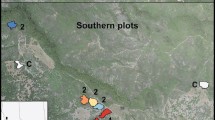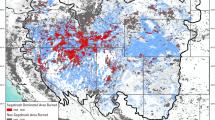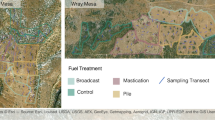Abstract
National fuel-reduction programs aim to reduce the risk of wildland fires to human communities and to restore forest and rangeland ecosystems to resemble their historical structure, function, and diversity. There are a number of factors, such as seed bank dynamics, post-treatment climate, and herbivory, which determine whether this latter goal may be achieved. Here, we examine the short-term (2 years) vegetation response to fuel-reduction treatments (mechanical mastication, broadcast burn, and pile burn) and seeding of native grasses on understory vegetation in an upland piñon–juniper woodland in southeast Utah. We also examine how wildlife herbivory affects the success of fuel-reduction treatments. Herbaceous cover increased in response to fuel-reduction treatments in all seeded treatments, with the broadcast burn and mastication having greater increases (234 and 160 %, respectively) in herbaceous cover than the pile burn (32 %). In the absence of seeding, herbaceous cover only increased in the broadcast burn (32 %). Notably, fuel-reduction treatments, but not seeding, strongly affected herbaceous plant composition. All fuel-reduction treatments increased the relative density of invasive species, especially in the broadcast burn, which shifted the plant community composition from one dominated by perennial graminoids to one dominated by annual forbs. Herbivory by wildlife reduced understory plant cover by over 40 % and altered plant community composition. If the primary management goal is to enhance understory cover while promoting native species abundance, our study suggests that mastication may be the most effective treatment strategy in these upland piñon–juniper woodlands. Seed applications and wildlife exclosures further enhanced herbaceous cover following fuel-reduction treatments.








Similar content being viewed by others
References
Anderson MJ (2001) A new method for non-parametric multivariate analysis of variance. Austral Ecol 26:32–46
Barger NN, Adams HD, Woodhouse C et al (2009) Influence of livestock grazing and climate on pinyon pine (Pinus edulis) dynamics. Rangel Ecol Manag 62:531–539
Bates JD, Miller RF, Svejcar T (2005) Long-term successional trends following western juniper cutting. Rangel Ecol Manag 58:533–541
Bates JD, Sharp RN, Davies KW (2013) Sagebrush steppe recovery after fire varies by development phase of Juniperus occidentalis woodland. Int. J. Wildland Fire 23:117–130
Battaglia M, Rhoades CC, Rocca ME, Ryan MG (2010) A regional assessment of the ecological effects of chipping and mastication fuels reduction and forest restoration treatments (Final report: Joint Fire Science Program No. 06-3-2-26)
Benjamini Y, Hochberg Y (1995) Controlling the false discovery rate: a practical and powerful approach to multiple testing. J R Stat Soc Ser B Methodol 57:289–300
Bestelmeyer BT, Khalil NI, Peters DPC (2007) Does shrub invasion indirectly limit grass establishment via seedling herbivory? A test at grassland-shrubland ecotones. J Veg Sci 18:363–371
Blank RR, Chambers J, Roundy B, Whittaker A (2007) Nutrient availability in rangeland soils: influence of prescribed burning, herbaceous vegetation removal, overseeding with Bromus tectorum, season, and elevation. Rangel Ecol Manag 60:644–655. doi:10.2307/4540872
Brockway DG, Gatewood RG, Paris RB (2002) Restoring grassland savannas from degraded pinyon-juniper woodlands: effects of mechanical overstory reduction and slash treatment alternatives. J Environ Manag 64:179–197. doi:10.1006/jema.2001.0522
Certini G (2005) Effects of fire on properties of forest soils: a review. Oecologia 143:1–10
Clarke K, Gorley R (2006) PRIMER v6: User Manual/Tutorial. PRIMER-E, Plymouth
Clary WP, Jameson DA (1981) Herbage production following tree and shrub removal in the pinyon-juniper type of Arizona. J Range Manag 34:109–113. doi:10.2307/3898124
Corbin JD, D’Antonio CM (2004) Competition between native perennial and exotic annual grasses: implications for an historical invasion. Ecology 85:1273–1283
Covington WW, Moore MM (1994) Postsettlement changes in natural fire regimes and forest structure. J Sustain For 2:153–181. doi:10.1300/J091v02n01_07
Craddock GW, Pease KC (1938) Surface run-off and erosion on granitic mountain soils of Idaho as influenced by range cover, soil disturbance, slope, and precipitation intensity. USDA, Washington DC, pp 1–24
Evangelista P, Stohlgren TJ, Guenther D, Stewart S (2004) Vegetation response to fire and postburn seeding treatments in juniper woodlands of the Grand Staircase-Escalante National Monument, Utah. West North Am Nat 64:293–305
Floyd ML, Hanna D, Romme WH, Crews T (2006) Predicting and mitigating weed invasions to restore natural post-fire succession in Mesa Verde National Park, Colorado, USA. Int J Wildland Fire 15:247–259
García LV (2004) Escaping the Bonferroni iron claw in ecological studies. Oikos 105:657–663. doi:10.1111/j.0030-1299.2004.13046.x
Gifford GF, Shaw CB (1973) Soil moisture patterns on two chained pinyon-juniper sites in Utah. J Range Manag 26:436–440. doi:10.2307/3896981
Gutiérrez JR, Meserve PL, Herrera S et al (1997) Effects of small mammals and vertebrate predators on vegetation in the Chilean semiarid zone. Oecologia 109:398–406. doi:10.1007/s004420050099
Hare RC (1961) Heat effects on living plants (Occasional Paper 183). U.S. Department of Agriculture, Forest Service, Southern Forest Experiment Station
Herrick JE, Bestelmeyer BT, Archer S et al (2006) An integrated framework for science-based arid land management. J Arid Environ 65:319–335. doi:10.1016/j.jaridenv.2005.09.003
Hill MO (1973) Diversity and evenness: a unifying notation and its consequences. Ecology 54:427–432. doi:10.2307/1934352
Horn KJ, McMillan BR, St. Clair SB (2012) Expansive fire in Mojave Desert shrubland reduces abundance and species diversity of small mammals. J Arid Environ 77:54–58
Huffman DW, Stoddard MT, Springer JD et al (2013) Understory plant community responses to hazardous fuels reduction treatments in pinyon-juniper woodlands of Arizona, USA. For Ecol Manag 289:478–488. doi:10.1016/j.foreco.2012.09.030
Jacobs BF, Gatewood RG (1999) Restoration studies in degraded pinyon-juniper woodlands of north-central New Mexico. Proc. Ecol. Manag. Pinyon-Juniper Communities Inter. West USDA For. Serv. Proc. RMRS-P-9 Rocky Mt. Res. Stn. Fort Collins CO. pp 294–298
Jiménez Esquilín AE, Stromberger ME, Massman WJ et al (2007) Microbial community structure and activity in a Colorado Rocky Mountain forest soil scarred by slash pile burning. Soil Biol Biochem 39:1111–1120. doi:10.1016/j.soilbio.2006.12.020
Koniak S, Everett RL (1982) Seed reserves in soils of successional stages of pinyon woodlands. Am Midl Nat 108:295–303. doi:10.2307/2425489
Mack RN, Pyke DA (1983) The demography of Bromus tectorum: variation in time and space. J Ecol 71:69–93. doi:10.2307/2259964
Manier DJ, Hobbs NT (2007) Large herbivores in sagebrush steppe ecosystems: livestock and wild ungulates influence structure and function. Oecologia 152:739–750. doi:10.1007/s00442-007-0689-z
Manrique R, Gutiérrez JR, Holmgren M, Squeo FA (2007) Reduced herbivory during simulated ENSO rainy events increases native herbaceous plants in semiarid Chile. Plant Ecol 191:21–31. doi:10.1007/s11258-006-9211-7
McAdoo JK, Longland WS, Cluff GJ, Klebenow DA (1987) Use of new rangeland seedings by black-tailed jackrabbits. J Range Manag 40:520–524. doi:10.2307/3898872
McIver J, Youngblood A, Stephens SL (2009) The National Fire and Fire Surrogate Study: ecological consequences of fuel reduction methods in seasonally dry forests. Ecol Appl 19:283–284. doi:10.1890/07-1785.1
Miller ME, Belnap J, Beatty SW, Reynolds RL (2006) Performance of Bromus tectorum L. in relation to soil properties, water additions, and chemical amendments in calcareous soils of southeastern Utah. USA. Plant Soil 288:1–18. doi:10.1007/s11104-006-0058-4
Natural Resource Conservation Service (NRCS) (2004) Major Land Resources Area: Colorado and Green River Plateaus. In: US Department of Agriculture Natural Resources Conservation Service. http://www.nrcs.usda.gov/wps/portal/nrcs/detail/ut/technical/landuse/pasture/?cid=nrcs141p2_034190. Accessed 31 July 2013
Neary DG, Klopatek CC, DeBano LF, Ffolliott PF (1999) Fire effects on belowground sustainability: a review and synthesis. For Ecol Manag 122:51–71. doi:10.1016/S0378-1127(99)00032-8
NFP (National Fire Plan) (2000) The National Fire Plan. In: US Department of Agriculture Forest. Rangelands. www.forestsandrangelands.gov/resources/overview. Accessed 10 July 2013
Noson AC, Schmitz RA, Miller RF (2006) Influence of fire and juniper encroachment on birds in high-elevation sagebrush steppe. West North Am Nat 66:343–353
O’Connor C, Miller R, Bates JD (2013) Vegetation response to western juniper slash treatments. Environ Manag 52:553–566. doi:10.1007/s00267-013-0103-z
Ogle D, John LS, Stannard M, Holzworth L (2010) Grass, grass-like, forb, legume, and woody species for the intermountain west. USDA, Natural Resources Conservation Service, Bozeman, Montana
Owen SM, Sieg CH, Gehring CA, Bowker MA (2009) Above- and belowground responses to tree thinning depend on the treatment of tree debris. For Ecol Manag 259:71–80. doi:10.1016/j.foreco.2009.09.044
Peet RK (1974) The measurement of species diversity. Annu Rev Ecol Syst 5:285–307
Pierson FB, Bates JD, Svejcar TJ, Hardegree SP (2007) Runoff and erosion after cutting western juniper. Rangel Ecol Manag 60:285–292
Potts JB, Stephens SL (2009) Invasive and native plant responses to shrubland fuel reduction: comparing prescribed fire, mastication, and treatment season. Biol Conserv 142:1657–1664. doi:10.1016/j.biocon.2009.03.001
Poulsen CL, Walker SC, Stevens R, et al (1999) Soil seed banking in pinyon-juniper areas with differing levels of tree cover, understory density and composition. SB Monsen R Stevens Comps Proc Ecol Manag Pinyon-Juniper Communities Inter West Ogden UT 141–154
R Development Core Team (2011) R: a language and environment for statistical computing. R Foundation for Statistical Computing, Vienna, Austria
Redmond MD, Cobb NS, Miller ME, Barger NN (2013) Long-term effects of chaining treatments on vegetation structure in piñon–juniper woodlands of the Colorado Plateau. For Ecol Manag 305:120–128. doi:10.1016/j.foreco.2013.05.020
Redmond MD, Golden ES, Cobb NS, Barger NN (2014) Vegetation management across Colorado Plateau BLM lands: 1950–2003. Rangel Ecol Manag. doi:10.2111/REM-D-13-00171.1
Ross MR, Castle SC, Barger NN (2012) Effects of fuels reductions on plant communities and soils in a piñon–juniper woodland. J Arid Environ 79:84–92. doi:10.1016/j.jaridenv.2011.11.019
Roundy BA, Young K, Cline N, Hulet A, Miller RF, Tausch RJ, Chambers JC, Rau B (In press) Piñon–Juniper Reduction Increases Soil Water Availability of the Resource Growth Pool. Rangel Ecol Manag. doi:10.2111/REM-D-13-00022.1
Sandoval L, Holechek J, Biggs J et al (2005) Elk and mule deer diets in north-central New Mexico. Rangel Ecol Manag 58:366–372
Schwilk DW, Keeley JE, Knapp EE et al (2009) The national Fire and Fire Surrogate study: effects of fuel reduction methods on forest vegetation structure and fuels. Ecol Appl 19:285–304. doi:10.1890/07-1747.1
Sheley RL, Bates JD (2008) Restoring western juniper- (Juniperus occidentalis) infested rangeland after prescribed fire. Weed Sci 56:469–476. doi:10.1614/WS-07-131.1
Skousen JG, Davis JN, Brotherson JD (1989) Pinyon-juniper chaining and seeding for big game in central Utah. J Range Manag 42:98–104. doi:10.2307/3899303
Tausch RJ, Tueller PT (1977) Plant succession following chaining of pinyon-juniper woodlands in eastern Nevada. J Range Manag 30:44–49. doi:10.2307/3897334
Thompson TW, Roundy BA, McArthur ED et al (2006) Fire rehabilitation using native and introduced species: a landscape trial. Rangel Ecol Manag 59:237–248. doi:10.2111/05-189R1.1
Verhoeven KJF, Simonsen KL, McIntyre LM (2005) Implementing false discovery rate control: increasing your power. Oikos 108:643–647. doi:10.1111/j.0030-1299.2005.13727.x
Weaver H (1943) Fire as an ecological and silvicultural factor in the ponderosa-pine region of the pacific slope. J For 41:7–15
Wilcox BP (1994) Runoff and erosion in intercanopy zones of pinyon-juniper woodlands. J Range Manag 47:285–295. doi:10.2307/4002549
Young KR, Roundy BA, Eggett DL (2013a) Plant establishment in masticated Utah juniper woodlands. Rangel Ecol Manag 66:597–607. doi:10.2111/REM-D-12-00094.1
Young KR, Roundy BA, Eggett DL (2013b) Tree reduction and debris from mastication of Utah juniper alter the soil climate in sagebrush steppe. For Ecol Manage 310:777–785. doi:10.1016/j.foreco.2013.09.024
Acknowledgments
We are most grateful to Mark Miller and Jeff Herrick who were critical in the early stages of this project for their help conceiving the project and developing the experimental design. For assistance with field sampling and/or laboratory work, we thank Sarah Castle, Scott Clingan, Bruce Condie, Gavin Dean, Matt Ellwood, Elizabeth Golden, Heidi Guenther, Ian Mallams, Conor Morrison, Michael Oro, Kayla O’Hara Reyna, Stephanie Shepard, Sarah Topp, and Lindsay Young. We are grateful to Brian Keating, Gabe Bissonette, and Paul Plemmons from the BLM for treatment implementation. We also thank Steven Peterson and two anonymous reviewers for helpful comments on previous versions of this manuscript. This research was supported by a USDA National Research Initiative—Managed Ecosystems grant (Proposal No. 2008-00776) and by a NSF Graduate Research Fellowship (Grant No. DGE 1144083).
Author information
Authors and Affiliations
Corresponding author
Electronic supplementary material
Below is the link to the electronic supplementary material.
Rights and permissions
About this article
Cite this article
Redmond, M.D., Zelikova, T.J. & Barger, N.N. Limits to Understory Plant Restoration Following Fuel-Reduction Treatments in a Piñon–Juniper Woodland. Environmental Management 54, 1139–1152 (2014). https://doi.org/10.1007/s00267-014-0338-3
Received:
Accepted:
Published:
Issue Date:
DOI: https://doi.org/10.1007/s00267-014-0338-3




